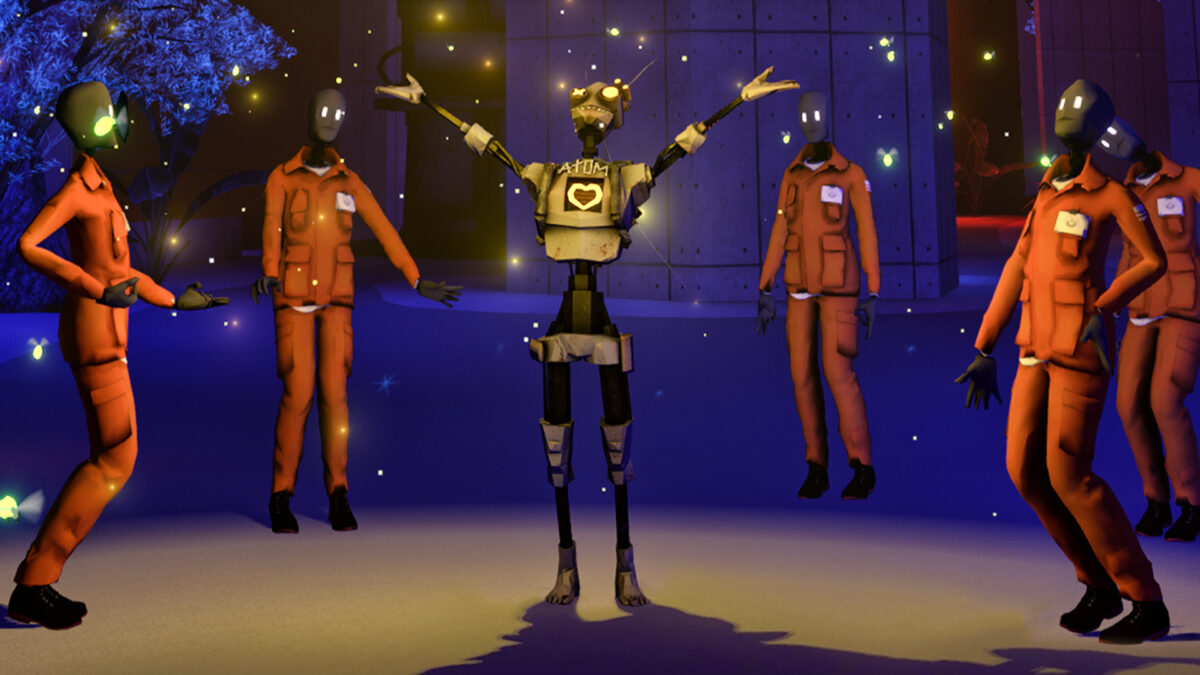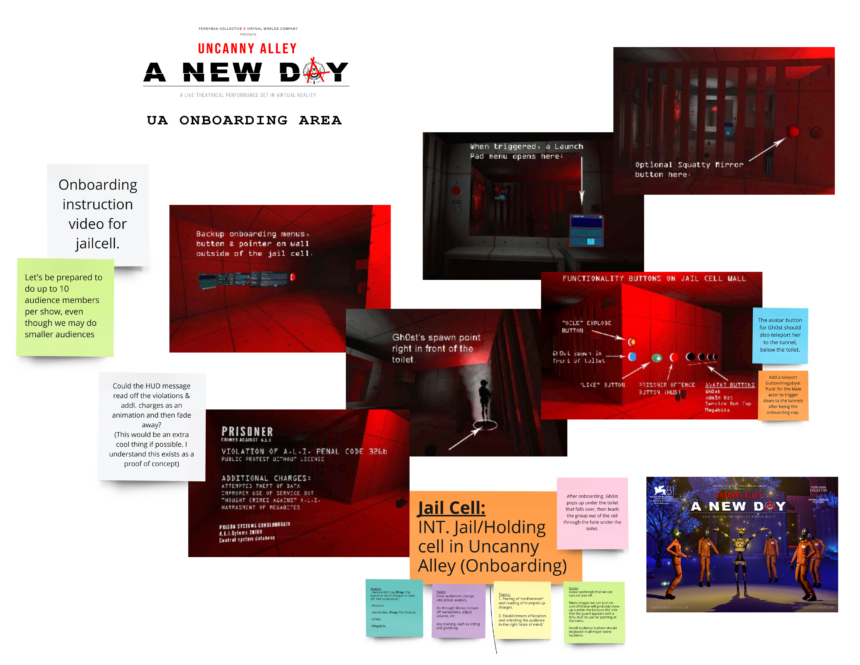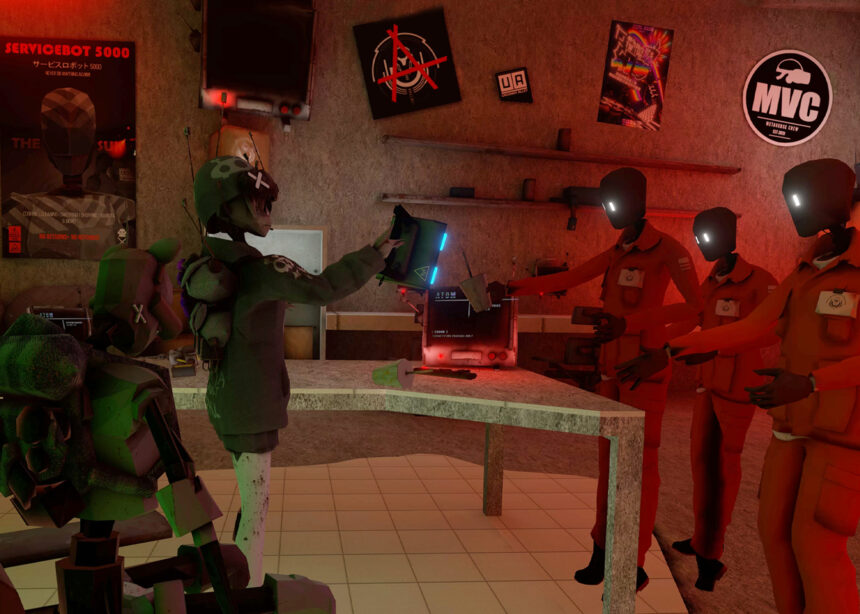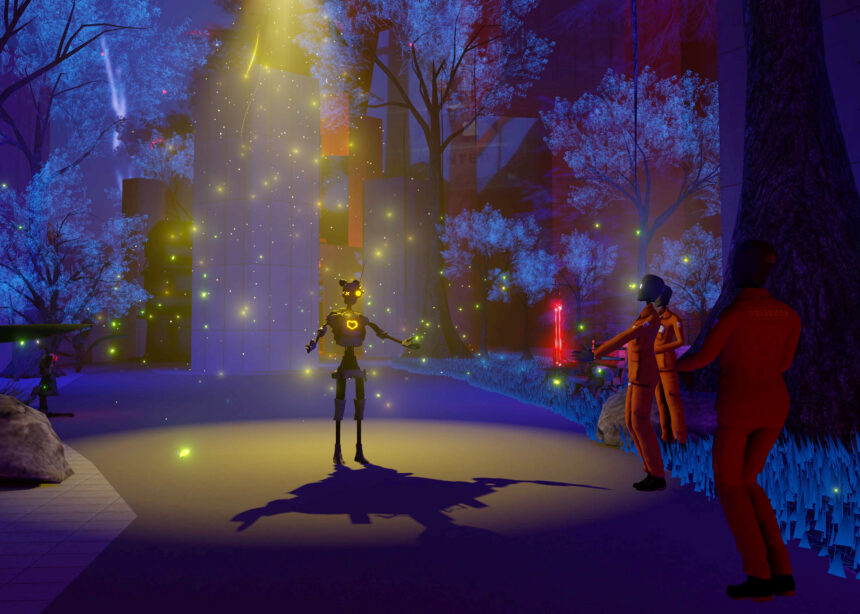A Walk through "Uncanny Alley" - VR Immersive Theater Production

Exploring Immersive VR Theater through "Uncanny Alley: A New Day" showing now.
“Uncanny Alley: A New Day” is an immersive VR theater production from Ferryman Collective and Virtual Worlds Company. Compelling writing, a versatile cast, and moving effects deliver a story about rebellion, enduring hope, and teaching a robot to love.
A Crash Course in Immersive Theater
If you’re coming to Ferryman Collective from a strictly VR background, you’d be forgiven for not knowing that immersive theater is older than VR. “Immersive Theater” is a kind of production in which audience members are active participants in the story. Think of it as similar to a role-playing game like Dungeons and Dragons but with (hopefully) more elaborate sets and props.

Behind-the-scenes reference material show special controls that cast and crew use to launch effects that feel natural to the audience members. Image: Ferryman Collective
Immersive VR theater takes the same principles and uses virtual reality. A cast of company characters interacts with the audience and guides them through the prepared plot. There’s also a team of operators using controls that the audience can’t see to trigger effects in the virtual environment.
Despite an existing script, this kind of production creates a one-of-a-kind experience each time that the play is performed. These productions are also laborious to put on.
With conventional theater, a cast and crew of only a few people can put on a performance for hundreds of spectators at a time. In immersive theater, there might be one or two cast members to two or even a single audience member.
Gumball Dreams, the last production that I saw by Ferryman Collective, had two cast members per three audience members. Uncanny Alley was a little more forgiving on the cast.
When I went through the production there were five other participants but it’s been done with as many as nine at a time. On the other hand, the production could use over a dozen actors, but could realistically get by with two or three in a pinch.
Welcome to Uncanny Alley
The production begins with the audience spawning into a prison cell. This might sound awkward or lazy, but you learn later that moving through portals is a common mode of transportation in the world in which the production takes place.
What Is Uncanny Alley?
The whole piece is named for the virtual city in which the action of the production takes place – Uncanny Alley. The grimy cyber-punk world was first introduced at Venice Immersive in 2022 by artist “MetaRick” (Rick Treweek) who co-created the play with Ferryman Collective’s Stephen Butchko.
MetaRick’s original Uncanny Alley was a conceptual demo to illustrate “the metaverse” as it is. The dark world featured portals created by hackers in unused toilets used to avoid “metaverse cops” who stopped users for things like “(Intellectual Property) Checks” on their avatars. His work also introduced characters like “Ghost” who are truly brought to life in the production.
Having this background knowledge about Uncanny Alley before you enter the performance is not necessary, though it will hardly hurt your experience. The character that you take on in the production is having memory problems partially due to rough treatment by enforcers and partially due to the bad actions by ALI, the metaverse service provider and necessary villain of Uncanny Alley.
Having learned all of this background information after experiencing the production, I feel like having it beforehand might have helped me understand my situation within the story. Though, that might not be what the writers intended.
Not having this background information led to genuine interactions with my fellow audience members as we honestly told one another and the prison guard that we didn’t know what we had done or why we were in jail. It also meant that we had a deeper reliance on and dedication toward the character of Ghost.
The Plot and Cast of Characters
The first characters that you meet are the jailer and a “compliance officer” outside of your cell. These characters serve the narrative function of explaining your charges (which include “thought crimes against ALI” and “Misuse of a service bot”). They also let slip that you are candidates for a menacingly vague experimental disciplinary procedure.
Briefly left to consider your situation, you and your fellow audience members are sprung from your cell by Ghost. The hacker/freedom-fighter explains that you and your fellow audience members were arrested for refusing to disperse while protesting ALI.
Their most recent oppression: forcing users to engage in pointless media interactions to be allotted data. As you flee the jail, you routinely encounter dead avatars displaying error messages that their data ran out – presumably due to willful or accidental non-compliance with ALI’s new policy.

Atom and Ghost (Left) shows characters around the home base early on in the production. Image: Ferryman Collective
The next character that you meet is Atom, a robot being developed by Ghost and struggling with new experiences like memories and human-like emotions. Audience members develop a bond with Atom as they help him navigate these experiences while he helps them to navigate Uncanny Alley.
Over the course of the production, you are helped by a number of other characters including a nightclub owner, a resistance blogger, and Ghost’s mom who helps hide you from the metaverse cops and provides you with a choice of new avatar skins.
Obstacles and Affordances of VR Immersive Theater
VRChat is an effective medium for immersive VR theater, but that isn’t what it was intended for. Whether Ferryman Collective was working with intuitive features or working through necessary obstacles, they are usually able to work the platform into the narrative itself.
Anything true of using VRChat for Immersive VR theater goes twice for Uncanny Alley. After all, the production itself takes place within a virtual world.
VRChat as a Medium
The jailers outside of your cell serve the necessary functions of “compliance assurance” (making sure that all audience members have the right VRChat settings in place for the production to work properly). They also provide a brief tutorial, encouraging audience members to walk and look around their cell, sit on the bench, and pick up trash
Although the “compliance” portion was a little clunky, this session was played into genuine story interactions and helped to ensure that anyone new to the platform has a hang of the basic controls. I hadn’t used VRChat since Gumball Dreams over a year ago, so this sequence was much appreciated.
The settings adjustments also allow a lot of the effects that helped make Uncanny Alley so compelling. ALI’s incursions into user experience – against which the characters of the story are so opposed – feel genuine as they occasionally dominate your view throughout the production.
Most of the audience members can theoretically go through most of the production just by moving and looking around. There are only two instances in which one or two audience members have the plot-dependent obligation to interact with objects. However, most audience members chose to interact with in-world objects like cups.
One part of the production involves a character entrusting an audience member to carry a device. This involved that participant holding down the controller trigger for quite some time. The audience member expressed growing discomfort from holding the device, which led to another audience member offering to carry the device for a while. The interaction helped me to appreciate what that audience member – and their character – must have been going through and presented a unique and organic opportunity for those two audience members to bond.
The World of Uncanny Alley
The virtual sets for Uncanny Alley were all created by MetaRick. The world is predominantly dark, though areas are dimly illuminated by classic cyberpunk neon in-world elements. Virtual effects such as the green thumbs-up icon with which residents are forced to interact to maintain their daily data allotments also periodically shed light on the world.

One of the characters shares a memory of a happier Uncanny Alley, drawing audience members into the story with effects by the artist Screaming Colors. Image: Ferryman Collective
During one fairly early sequence, the world is also briefly brought to new life as audience members share a memory with Atom. The interaction helped to invest me in the characters of Atom and Ghost as well as the world of Uncanny Alley itself.
This sequence, as well as the other visual effects of the narrative, are created by Christopher Lane Davis (“Screaming Color”). His bright and colorful VR world inspired Gumball Dreams and his focus on contrast does much for the darker more monochromatic world of Uncanny Alley. This familiarity with Screaming Color also helps to provide hope for the kind of virtual world that a liberated Uncanny Alley could become.
Avatars and Identity
VR is an inherently visual medium that places you not just within a virtual world, but within a character of that world. Using your avatar to guide you into character is a time-tested strategy of Ferryman Collective which actually plays out twice throughout Uncanny Alley – both times expertly executed for massive effect.
All audience members begin as identical humanoid robot avatars in identical ALI jumpsuits. We naturally tried to introduce ourselves and get to know one another, but not being able to tell one another apart was one of the eerie and disorienting first obstacles of life in Uncanny Alley.
As a session administrator, Ghost can see information on audience members allowing her to call us each by name. At this point, she also commended each of us on some behavior that made us stand out during the ill-fated protest. This helps to build an emotional attachment with Ghost as well as to establish her as a link in our foggy shared past.
The point in the story at which Ghost’s mom gives the audience their own choice in avatar skins comes shortly after this moment. This serves the simple purpose of allowing the audience members to tell one another apart. From here on out, the audience interactions feel more independent from the guiding hand of the actors, which could feel somewhat heavier in the earlier moments of the production.
It also allows each audience member to choose an avatar that they feel reflects their character and claim a greater sense of individuality within the world. When the character is looking for a volunteer to carry the plot-dependent item, the audience member who stepped up did so on the grounds that she was “big” - a reference to that avatar that she had chosen at this earlier point in the story.
What’s Next for Uncanny Alley?
We don’t know what’s next for Uncanny Alley. The fact that the production title has a subheading makes me hopeful that we might see more productions set in this universe. Further, the ending of the play left a lot to be hoped for.
At the end of the production, audience members are faced with a choice. You can leave Uncanny Alley with Ghost, or you can stay behind with Atom and continue to help the residents of Uncanny Alley. I would love to see more immersive VR theater pieces set in this world – maybe one that follows Ghost and one that follows Atom continuing where this adventure ends.
Note: Links to online stores in articles can be so-called affiliate links. If you buy through this link, MIXED receives a commission from the provider. For you the price does not change.